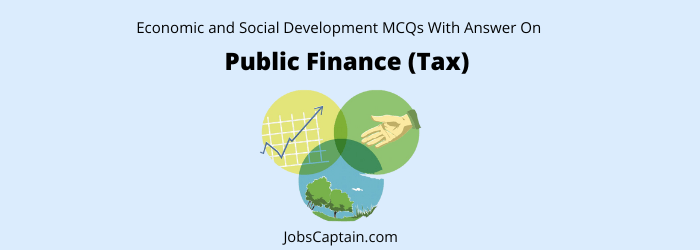
This is the second set of multiple choice questions on public finance. The questions cover a range of topics including budgeting, taxation, and debt.
| Quiz | 1 | 2 |
| Return To | Economic and Social Development MCQ | |
Question 1: Which tax is levied and collected by the Union Government but distributed between the Union and the States?
(A) Import duty
(B) Central Excise duty
(C) Export duty
(D) None of the above
Question 2: Which one of the following statements regarding the levying, collecting and distribution of Income Tax is correct?
(A) The Union levies, collects and distributes the proceeds of income tax between itself and the states
(B) The Union levies, collects and keeps all the proceeds of income tax to itself
(C) The Union levies and collects the tax, but all the proceeds are distributed among the states
(D) Only the surcharge levied on income tax is shared between the Union and the States
Question 3: The tax on Import and Export is known as __________.
(A) Income Tax
(B) Trade Tax
(C) Custom Duty
(D) None of the above
Question 4: Who had suggested an imposition of ‘expenditure tax’ in India for the first time?
(A) Kalecki
(B) Kaldor
(C) R.J. Chelliah
(D) Gautam Mathur
Question 5: The main source of revenue for the National Highway Authority of India is __________.
(A) Cess
(B) Foreign assistance
(C) Market borrowings
(D) Budgetary support of Union Government
Question 6: MODVAT is related to __________.
(A) Excise Duty
(B) Value Added Tax (VAT)
(C) Wealth Tax
(D) Income Tax
Question 7: Which one of the following is not a tax/duty levied by the Government of India?
(A) Service Tax
(B) Education Cess
(C) Custom Duty
(D) Toll Tax
Question 8: Consider the following taxes.
- Corporation Tax
- Customs Duty
- Wealth Tax
- Excise Duty
Which of these is/are indirect taxes?
(A) Only 1
(B) 2 and 4
(C) 1 and 3
(D) 2 and 3
Question 9: A redistribution of income in a country can be best brought through ___________.
(A) Progressive taxation combined with progressive expenditure
(B) Progressive taxation combined with regressive expenditure
(C) Regressive taxation combined with regressive expenditure
(D) Regressive taxation combined with progressive expenditure
Question 10: The Minimum Alternate Tax (MAT) was introduced in the Budget of the Government of India for the year ___________.
(A) 1991-92
(B) 1995-96
(C) 1993-94
(D) 1996-97
Question 11: Consider the following statements.
In India, Stamp duties on financial transactions are
- Levied and collected by the state
- Appropriated by the Union Government
Which of these statement(s) is/are correct?
(A) Only 1
(B) Only 2
(C) Both 1 and 2
(D) Neither 1 nor 2
Question 12: Which of the following tax is levied by Union but collected and appropriated by States?
(A) Stamp Duties
(B) Passenger & Goods Tax
(C) Taxes on Newspapers
(D) None of the above/More than one of the above
Question 13: Service Tax in India was introduced in the year __________.
(A) 1994-95
(B) 1996-97
(C) 1998-99
(D) 1991-92
Question 14: Consider the following taxes.
- Sales Tax
- Income Tax
- Corporate Tax
- Entertainment Tax
Which of the above taxes are levied by the state government and not shared by central government?
(A) Only 1 and 2
(B) Only 2 and 3
(C) Only 3 and 4
(D) Only 1 and 4
Question 15: Consider the following in relation with Corporate tax.
- Total turnover of the company
- Profit after distribution of dividend
- Profit before distribution of dividend
- Capital employed in the company
Which one of the above is basis of corporate tax?
(A) 1 alone
(B) 2 alone
(C) 3 alone
(D) 4 alone
Question 16: Find the tax which is direct tax among the following.
(A) House Tax
(B) Service Tax
(C) Entertainment Tax
(D) Value Added Tax
Question 17: The most important source of revenue for Indian Government is __________.
(A) Direct Tax
(B) Indirect Tax
(C) Deficit financing
(D) Loans from RBI
Question 18: Consider the following statements.
In India, taxes on transactions in Stock exchanges and Futures Markets are
- Levied by the union
- Collected by the States
Which of the statement(s) given above is/are correct?
(A) Only 1
(B) Both 1 and 2
(C) Neither 1 nor 2
(D) Only 2
Question 19:Consider the following actions by the government.
- Cutting the tax rates
- Increasing the government spending
- Abolishing the subsidies
In the context of economic recession, which of the above actions can be considered a part of the ‘fiscal stimulus’ package?
(A) 1 and 2
(B) Only 2
(C) 1 and 3
(D) 1, 2 and 3
Question 20: What has been kept under the purview of Goods and Services Tax (GST)?
(A) Alcohol for human consumption
(B) Electricity
(C) Petroleum products
(D) Ghee
Question 21: Direct Tax Code in India is related to which of the following?
(A) Sales Tax
(B) Income Tax
(C) Excise Tax
(D) Service Tax
Question 22: Which of the following taxes is levied by the Gram Panchayats?
(A) Sales Tax
(B) Land Revenue Tax
(C) Tax on local fairs
(D) None of the above
Question 23: Consider the following items.
- Cereal grains hulled
- Chicken eggs cooked
- Fish processed and canned
- Newspapers containing advertising material
Which of the above item is/are exempted under GST (Goods and Service Tax)?
(A) Only 1
(B) Only 2 and 3
(C) Only 1, 2 and 4
(D) 1, 2, 3 and 4
| Quiz | 1 | 2 |
| Return To | Economic and Social Development MCQ | |
